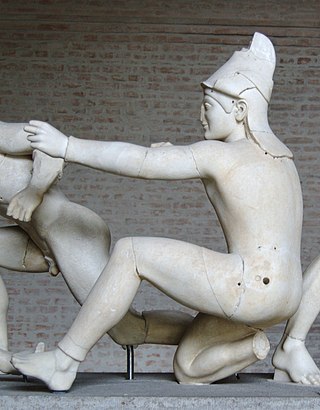
Marble is a metamorphic rock consisting of carbonate minerals (most commonly calcite (CaCO3) or dolomite (CaMg(CO3)2)) that have recrystallized under the influence of heat and pressure. It has a crystalline texture, and is typically not foliated (layered), although there are exceptions.

Marble has been the preferred material for stone monumental sculpture since ancient times, with several advantages over its more common geological "parent" limestone, in particular the ability to absorb light a small distance into the surface before refracting it in subsurface scattering. This gives an attractive soft appearance that is especially good for representing human skin, which can also be polished.

Carrara marble, Luna marble to the Romans, is a type of white or blue-grey marble popular for use in sculpture and building decor. It has been quarried since Roman times in the mountains just outside the city of Carrara in the province of Massa and Carrara in the Lunigiana, the northernmost tip of modern-day Tuscany, Italy.

Bluestone is a cultural or commercial name for a number of dimension or building stone varieties, including:

The makhaira is a type of Ancient Greek bladed weapon and tool, generally a large knife or sword, similar in appearance to the modern day machete, with a single cutting edge.

Ashlar is a cut and dressed stone, worked using a chisel to achieve a specific form, typically rectangular in shape. The term can also refer to a structure built from such stones.

Yule Marble is a marble of metamorphosed Leadville Limestone found only in the Yule Creek Valley, in the West Elk Mountains of Colorado, 2.8 miles (4.5 km) southeast of the town of Marble, Colorado. First discovered in 1873, it is quarried underground at an elevation of 9,300 feet (2,800 m) above sea level—in contrast to most marble, which is quarried from an open pit and at much lower elevations.

Dimension stone is natural stone or rock that has been selected and finished to specific sizes or shapes. Color, texture and pattern, and surface finish of the stone are also normal requirements. Another important selection criterion is durability: the time measure of the ability of dimension stone to endure and to maintain its essential and distinctive characteristics of strength, resistance to decay, and appearance.

The Temple of Zeus at Olympia was an ancient Greek temple in Olympia, Greece, dedicated to the god Zeus. The temple, built in the second quarter of the fifth century BC, was the very model of the fully developed classical Greek temple of the Doric order.

Jerusalem stone is a name applied to various types of pale limestone, dolomite and dolomitic limestone, common in and around Jerusalem that have been used in building since ancient times. One of these limestones, meleke, has been used in many of the region's most celebrated structures, including the Western Wall.
Belgian marble is the name given to limestone extracted in Wallonia, southern Belgium.

Crushed stone or angular rock is a form of construction aggregate, typically produced by mining a suitable rock deposit and breaking the removed rock down to the desired size using crushers. It is distinct from naturally occurring gravel, which is produced by natural processes of weathering and erosion and typically has a more rounded shape.

Meleke, also transliterated melekeh or malaki, is a lithologic type of white, coarsely-crystalline, thickly bedded-limestone found in the Judaean Mountains in Israel. It has been used in the traditional architecture of Jerusalem since ancient times, especially in Herodian architecture. Though it is often popularly referred to as Jerusalem stone, that phrase can refer to a number of different types of stone found and used in or associated with Jerusalem.
Sivec is the trademark of the dolomitic marble extracted from the quarries of Mermeren Kombinat A.D., near the town of Prilep in North Macedonia. The fine grain makes it ideal for sculpture and architectural applications.

Verd antique, also called verde antique, marmor thessalicum, or Ophite, is a serpentinite breccia popular since ancient times as a decorative facing stone. It is a dark, dull green, white-mottled serpentine, mixed with calcite, dolomite, or magnesite, which takes a high polish. The term verd antique has been documented in English texts as early as 1745.

Istrian stone, pietra d'Istria, the characteristic group of building stones in the architecture of Venice, Istria and Dalmatia, is a dense type of impermeable limestone that was quarried in Istria, nowadays Croatia; between Portorož and Pula. Limestone is a biogenetic stone composed of calcium carbonate from the tests and shells of marine creatures laid down over eons. Istrian stone approaches the compressive strength and density of marble, which is metamorphosed limestone. It is often loosely referred to as "marble", which is not strictly correct.

The Sugar Run Dolomite is a geologic formation in Illinois. It is a finely-bedded dolomite, preserving fossils dating back to the Silurian period. This formation is named for the Sugar Run stream in Joliet, along which it is well exposed. The dolomite is off-white/grey on freshly cut surfaces, but over time oxidizes to a distinctive cream yellow color, due to trace presence of iron. It is a member of the Niagaran series.

Phenix is an unincorporated community in northwest Greene County, in the U.S. state of Missouri. The community is located on the banks of Sugar Creek, approximately 2.5 miles south of Walnut Grove and 1.5 miles west of Harold and Missouri Route 123.















